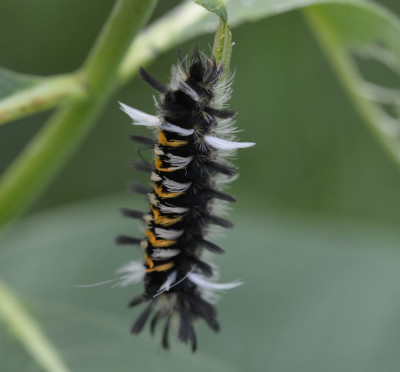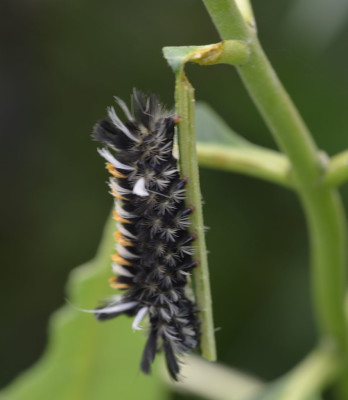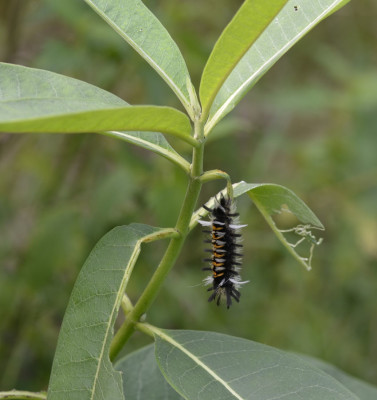Most Canadian children grow up being read stories about Monarch butterfly caterpillars feeding on Milkweed leaves. They may be surprised when they see a totally different caterpillar chewing steadily away on a Common Milkweed leaf. These other ones are very spiky looking with black and white tufts and a strange colour combination of orange, black and white. They aren’t butterfly caterpillars, though, they are moth caterpillars.

A Milkweed Tussock Moth caterpillar hanging out.
We used to see these caterpillars fairly often when I was growing up but I haven’t noticed them in recent years. Then, while on a guided nature walk at the Riverwood Conservancy in August, one of the participants pointed out two of them eating away at a Common Milkweed plant in the Maintenance Loop.
Be Careful! Don’t Pick Up a Tussock Moth Caterpillar!
Just a word of caution: Many Tussock Moth caterpillars have spines that can cause mild to severe skin irritation if people handle them. It’s best to just observe them from a distance and not risk injury.
What Made These Holes in a Milkweed Leaf?
You can see the type of damage this almost mature caterpillar has made to this leaf.
According to Bugguide, when they are tiny, Milkweed Tussock Moth caterpillars often feed together on the same plant but they usually move away to their own plants as they get near maturity.
Different insects, and insects at different sizes in their life cycles, often make different types of holes in milkweed. Baby monarch caterpillars, for example, usually eat from the underside and often don’t get all the way up through the leaf. Milkweed Beetles often chew pieces out of the edges of leaves.
Hey, Someone Pooped On This Leaf!
One way to spot caterpillars, which often hide underneath leaves while munching, is to look for the “frass.” This pile was deposited by one of these Milkweed Tussock Moth caterpillars while it ate.
Are Milkweed Tussock Moths Large and Showy Like Monarch Butterflies?
Unfortunately, I don’t have a photo of one of these moths. You can see some nice ones online, though, on the Bugguide webpage. The body has some interesting orange, black and white markings but overall the moth is quite plain.
The wingspan, according to Bugguide, is 32-43 mm (or about 1-2 inches.)

Notice the little reddish “feet” add extra colour.
I’ll keep an eye out for the moths now I know that they are around but I’m skeptical whether I will find any. In the meantime, I enjoyed a chance to see an old friend from my childhood.
Related Reading
- How to Sex Monarchs
- Monarchs Sail Across the Lake in September
- Standing Still Watching the Rattray Parade
Join In
Have you seen any of these brightly coloured caterpillars in your neighbourhood? Please share your sighting with a comment.



